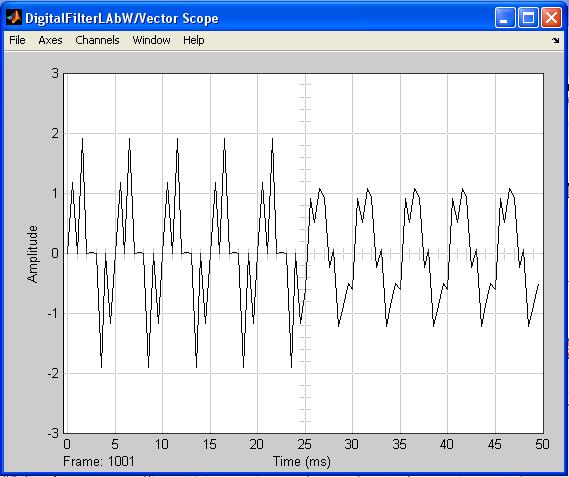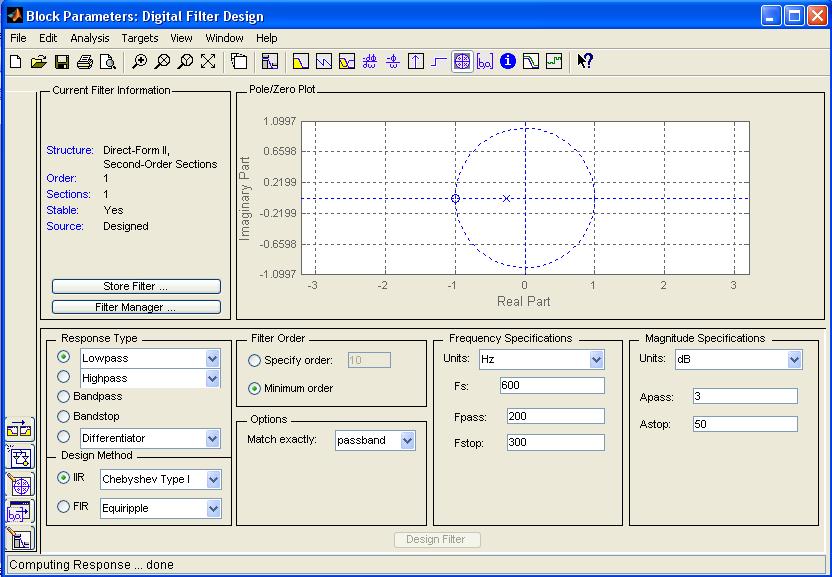
3. Fir filter design via weighting method.
The useful signal x1 is accompanied with a white noise x2 whose intensity is equal to Ash. For odd variants x1=As·sin(2πt/T) and for even variants x1=As·cos(2πt/T). It is known the order of the filter and sampling time Ts. It is necessary:
to plot useful signal x1;
to generate white noise x2 with intensity Ash;
to plot white noise x2;
to calculate and plot noisy signal x;
to calculate cut-off frequency;
to design two low-pass filter with given windows;
to plot impulse and frequency response of the designed filters;
to perform filtration of noisy signal x by means of both filter and filtfilt operators.
To define a cut-off frequency it is necessary perform normalization procedure. LPF normalized frequency is defined as follows
 .
.
Let us define normalized frequency ωn for Variant 7. According to initial data T=0.001 s and Tc=5 s. thus, normalized frequency is defined as

Variant 1
Rectangular and Hamming windows.
t=20 sec; As=0.75; T=1 sec; Ash=0.3; Ts=0.01 sec; N=10.
Variant 2
Rectangular and Hamming windows.
t=15 sec; As=5; T=10 sec; Ash=0.9; Ts=0.005 sec; N=30.
Variant 3
Rectangular and Blackman windows.
t=30 sec; As=1; T=2 sec; Ash=0.4; Ts=0.01 sec; N=16.
Variant 4
Rectangular and Blackman windows.
t=25 sec; As=7; T=10 sec; Ash=1; Ts=0.001 sec; N=40.
Variant 5
Rectangular and Hamming windows.
t=10 sec; As=1.5; T=2 sec; Ash=0.2; Ts=0.001 sec; N=20.
Variant 6
Rectangular and Hamming windows.
t=30 sec; As=7; T=20 sec; Ash=1.2; Ts=0.003 sec; N=40.
Variant 7
Rectangular and Blackman windows.
t=20 sec; As=3; T=5 sec; Ash=0.4; Ts=0.001 sec; N=20.
Variant 8
Rectangular and Blackman windows.
t=25 sec; As=11; T=30 sec; Ash=1.5; Ts=0.007 sec; N=120.
Variant 9
Rectangular and Hamming windows.
t=25 sec; As=5; T=8 sec; Ash=0.7; Ts=0.005 sec; N=30.
Variant 10
Rectangular and Blackman windows.
t=20 sec; As=0.5; T=20 sec; Ash=0.1; Ts=0.002 sec; N=60.
Example 3
Let us
consider a procedure of low pass Butterworth filter design that meets
the following performance requirements:
![]() Hz,
Hz,
![]() Hz, maximum pass band ripples,
Hz, maximum pass band ripples,
![]() ,
dB, stop band ripples
,
dB, stop band ripples
![]() ,
dB. By defining filter specification within Digital Filter Design
Block parameters, we obtain the Butterworth LPF of the order, n=1.
The result of appropriate filter functioning is given in Fig.8. The
filter zeros and poles location is given in Fig.9.
,
dB. By defining filter specification within Digital Filter Design
Block parameters, we obtain the Butterworth LPF of the order, n=1.
The result of appropriate filter functioning is given in Fig.8. The
filter zeros and poles location is given in Fig.9.

Figure 8 Simulation results

Figure 9 Filter Zero-Pole Plot
